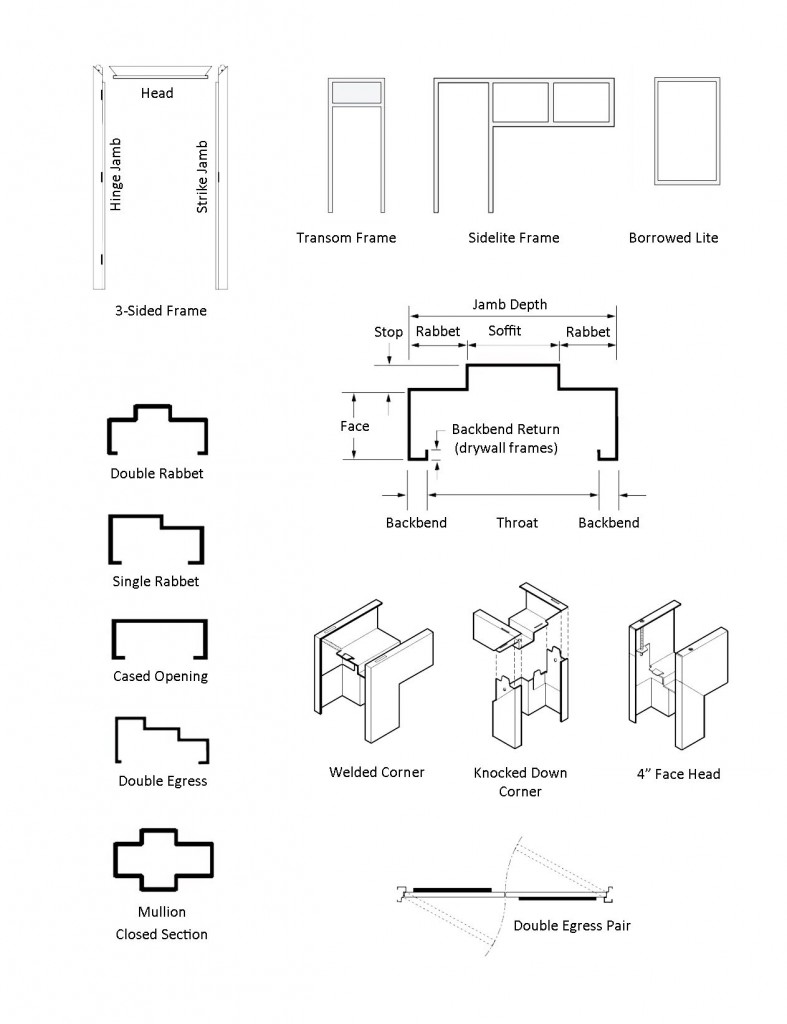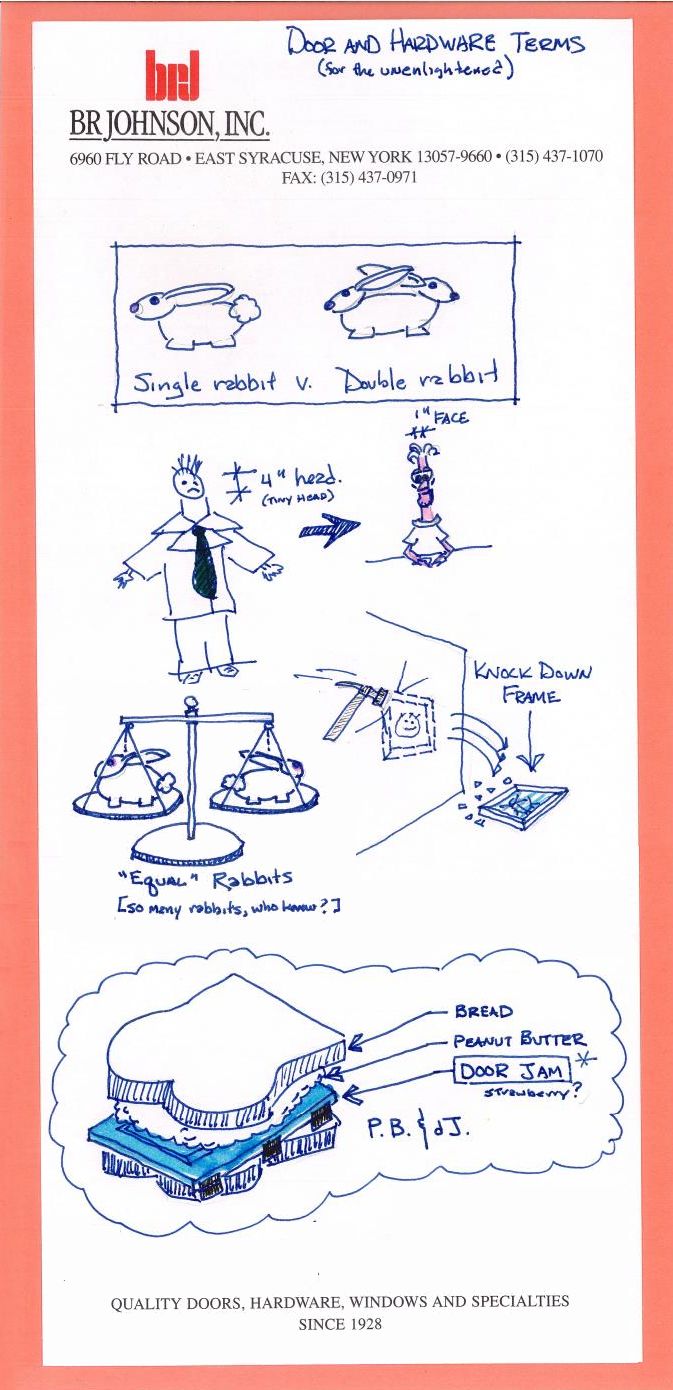 This is SO COOL. I LOVE it. I know it probably seems like it doesn’t take that much to excite me, but when this hit my inbox, it really made my day…when Dan Dateno of BR Johnson combined his sketching ability with his career in doors and hardware to illustrate alternate definitions for common door and hardware terminology. I thought it would be fun to combine Dan’s sketches with my informative (but some would say, “boring”) explanations of these terms. Awesome, right??
This is SO COOL. I LOVE it. I know it probably seems like it doesn’t take that much to excite me, but when this hit my inbox, it really made my day…when Dan Dateno of BR Johnson combined his sketching ability with his career in doors and hardware to illustrate alternate definitions for common door and hardware terminology. I thought it would be fun to combine Dan’s sketches with my informative (but some would say, “boring”) explanations of these terms. Awesome, right??
I’ve been in many meetings where the unenlightened in the room would just sit with a glazed expression while I spoke the language of doors and hardware with a hardware supplier or security integrator. If you’ve ever been at the glazed end of the table, this is your chance to learn more about terminology related to openings, a little at a time. And in alignment with one of my original goals for this site, I hope Dan’s alternate definitions will be a little less painful than studying a catalog or a product standard.
Frame Profiles
In woodworking terminology, a rabbet is a step-shaped recess cut along the edge or into the face of a piece of wood. The term “rabbet” is applied to hollow metal frames as well, and describes the part of the frame where the door sits when it is in the closed position. Most frames have a double rabbet profile, which means that there are rabbets on both sides with a stop in the middle. Double rabbet frames may have equal rabbets, where both rabbets typically measure 1-15/16″ wide, or unequal rabbets, where one measures 1-15/16″ (the door rabbet) and the other measures 1-9/16″.
Other common frame profiles include single rabbet, cased opening, and double egress frames (see drawings below).
- Single rabbet frames are usually used when there is an aesthetic preference for this profile, or when the jamb depth is very narrow.
- Cased opening frames are used when there is no door, or the door is double-acting, including openings with rescue hardware, which allow an inswinging restroom door to become outswinging when a person in the restroom needs emergency assistance.
- Double egress frames are typically used for cross-corridor pairs which provide egress in both directions, with one door leaf swinging in each direction.
Custom profiles are also available, but will typically add to the cost and lead time.
Frame Faces
The standard hollow metal frame face is 2 inches wide. Frames with a narrow face dimension are available (typically 1 inch or 1 1/2 inch), but must be carefully coordinated with the hardware as some hardware items require a wider face dimension. A 4-inch face head is sometimes used to align the top of the frame with masonry coursing, or to support an automatic operator or concealed closer.
Frame Components
The parts of a 3-sided frame are referred to as the head and jambs. Sidelite, borrowed lite, and transom frames have additional components – mullions, a transom bar, and/or a sill.
- Hinge Jamb – the vertical component that the door is hung on (3-sided pair frames have 2 hinge jambs)
- Strike Jamb – the vertical component where the strike is mounted and the door latches
- Head – the horizontal component across the top of the frame
- Mullion – may be vertical or horizontal – typically a closed section between lites of glass, or between doors, or between a door and glass lites
- Transom Bar – horizontal closed section between the top of a door and the bottom of a transom lite or transom panel (not all transom frames have transom bars)
- Sill – horizontal component across the bottom of a sidelite
Frame Assembly
Depending on how a frame will be installed, it may be ordered as a welded or knocked down frame. Welded frames (AKA SUA – “set up arc welded”) are welded by the manufacturer or a local hollow metal shop, and arrive at the job-site assembled. Sidelite, borrowed lite, and transom frames are almost always welded before being delivered to the site. Welded frames must be installed before the walls are complete, unless they are installed with existing wall anchors. A welded frame may be more “aesthetically pleasing” because the joints at the corners are not visible, but in addition to the cost of the welding, these frames are more expensive to ship than knocked down frames.
Knocked down frames arrive on site as components, and are assembled as they are installed. Depending on the wall construction and the type of anchor used, a knocked down frame can be installed as a masonry wall is built, or in a rough opening in a stud wall with drywall installed afterward. A drywall frame is a type of knocked down frame that is installed after drywall is in place, using compression anchors. Drywall frames have an extra backbend return to protect the drywall during installation.
 You can find a lot more information about hollow metal doors and frames in the Steelcraft Technical Data Manual.
You can find a lot more information about hollow metal doors and frames in the Steelcraft Technical Data Manual.
If the mood strikes, Dan may even find the time and inspiration to doodle some other door and hardware definitions, so leave some ideas below for nomenclature you’d like to see defined. And if there’s something else I should add to my descriptions of the above terminology, let me know!
You need to login or register to bookmark/favorite this content.






There’s probably some humor in “left hand reverse”
What about borrowed light?
Let him tackle “dogging”
Nice! Just one more reason to refer people to your site.
Quick point: we’re not limited to using the “double-egress profile” frame type at every double-egress opening — there’s a single-rabbet version available from some mfrs with offset jamb legs to maximize the opening width when the door leafs are in a held-open position [jam(b) legs? offset? leafs? –> more visuals?].
dogging / horseing all the same:::
http://www.narratives.co.uk/ImageThumbs/PE003_21/3/PE003_21_Horse_and_dog_in_front_of_stable_door.jpg
or
http://www.dogbreedinfo.com/images20/BrunoBoxerPuppy18WeeksWalk2.JPG
I wonder what a terminated stop would look like. Maybe a stop sign in the cross-hairs of a sniper rifle. Since they are also known as sanitation stops I imagine my messy kids.
Congratulations on your anniversary! Hope you got a cake to celebrate! Or lunch or something else!!
This is great Lori as I have this same BR Johnson Door and Hardware terms displayed in my cube. I forget how I even got it. I think it’s great and people that see it, love it (well if they are door hardware people).
Hi Lori,
Would it be possible for you to attach a PDF of this (as I have seen on a previous article)???
Thanks!
Hi Lori,
If possible, would you please attach this a PDF for download.
Thanks!
Hi Lynn –
Are you looking for the whole post as a PDF?
– Lori
Hi Lori,
Yes, if it’s not a problem. I am new to the industry and have been gaining a lot of useful knowledge from your blog, thank you. I would love to print out and keep as a quick reference sheet.
Thanks!
No problem, I’ll post it as soon as I have a chance.
– Lori